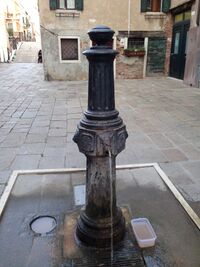Fountain: Difference between revisions
No edit summary |
No edit summary |
||
| Line 10: | Line 10: | ||
==Types of Fountains== | ==Types of Fountains== | ||
In the Venetian Lagoon, there are multiple types of fountain according to their design. These types include Delfini, Puglia, Alto, Ott. Basso, San marco, Cylindro, Pozzo, Tubo, and Neri. | In the Venetian Lagoon, there are multiple types of fountain according to their design and shape. These types include Delfini, Puglia, Alto, Ott. Basso, San marco, Cylindro, Pozzo, Tubo, and Neri. Some of them have solid rectangular shape with some fancy designed lid at the top (i.e. Neri), while some of them are just a simple tube with a spout (i.e. Tubo). | ||
<gallery> | <gallery> | ||
File:Fountain Types.png|Types of Fountain | File:Fountain Types.png|Types of Fountain | ||
</gallery> | </gallery> | ||
== | ==Material== | ||
The majority of the fountains in the Venetian Lagoon are metal and only a few of them are stone. Because of this, many fountains suffer from natural damage such as algae and especially rust. The location of Venice exacerbates this problem even more. | |||
<gallery> | |||
File:Stone Fountain.JPG|Stone Fountain with algae | |||
File:Metal fountain with rust and algae.JPG|Metal fountain with rust and algae | |||
</gallery> | |||
== Shape == | == Shape == | ||
Revision as of 11:30, 22 December 2014
This page contains information about a typical Venetian fountain.
A fountain, fontana, is a public drinking water system in Venice. It serves potable water to the public and locates all over the city. The majority of fountains run continuously whereas only a few of them have a push button to operate. Among the 142 fountains in Venice, only half of them are functional. The Venetian Fountain serves not only a practical purpose, but also as a unique aspect of Venetian vernacular art. see Public art preservation

History
A fountain, known locally as “fontana”, is the structure that dispenses public potable water in the City of Venice. An aqueduct system was completed from mainland in the late 1800's, which enabled a fountain system to emerge and to release a stream of safely potable water. These fountains usually locate in a “campo” or a street where they can be seen easily by the public. Some typical fountains were individually made with impressive design and some were mass-produced.
Types of Fountains
In the Venetian Lagoon, there are multiple types of fountain according to their design and shape. These types include Delfini, Puglia, Alto, Ott. Basso, San marco, Cylindro, Pozzo, Tubo, and Neri. Some of them have solid rectangular shape with some fancy designed lid at the top (i.e. Neri), while some of them are just a simple tube with a spout (i.e. Tubo).
-
Types of Fountain
Material
The majority of the fountains in the Venetian Lagoon are metal and only a few of them are stone. Because of this, many fountains suffer from natural damage such as algae and especially rust. The location of Venice exacerbates this problem even more.
-
Stone Fountain with algae
-
Metal fountain with rust and algae
Shape
A typical wellhead has an overall cylindrical or square shape. Often the shape of the base and the shape of the rim are different. The shape of the base is consistently circular while the shape of the rim varies between circular, square, hexagonal and octagonal.
Material
A Wellhead is constructed with either brick, Istria stone, Red Verona or White Verona. A brick wellhead however will deteriorate over time and as a result the typical wellhead of today is made of Istria Stone, Red Verona or White Verona with only a few exceptions. See Wellheads page. Istria stone is a type of limestone that has a gray-green or yellowish color. Lengthy exposure to the atmosphere causes the stone to obtain a whitish appearance through a process called “whitewashing.” Unfortunately, this also makes Istria stone a prime candidate for exfoliation. Verona marble is a sedimentary rock composed of organic limestone and fossils. It has either a reddish or whitish color depending on the carbon compounds it contains.
-
A wellhead made of Istrian Stone
-
A wellhead made of Red Verona Stone
-
A wellhead made of White Verona Stone
Lid
The Lid of a wellhead is typically circular in shape and either flat or convex in shape. The material of the lid is typically metal, wood or concrete with a few exceptions.
-
A wellhead that has a metal lid
-
A wellhead that has a concrete lid
-
A wellhead in Chioggia that has a statue as the lid
Serving Nature
In the past, these wellheads served as access points to fresh water for not only the human population of Venice, but the animals as well. Small, bowl-shaped indentations were made in the platforms of some wellheads. These indentations served as a source of fresh drinking water and as baths for the local wild life.
See also
References
Bibliography
NULL








